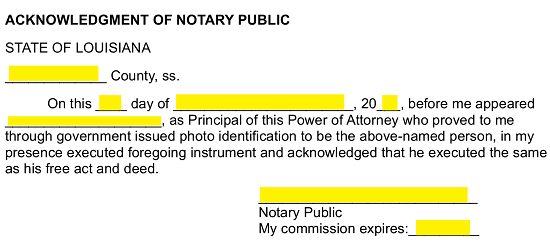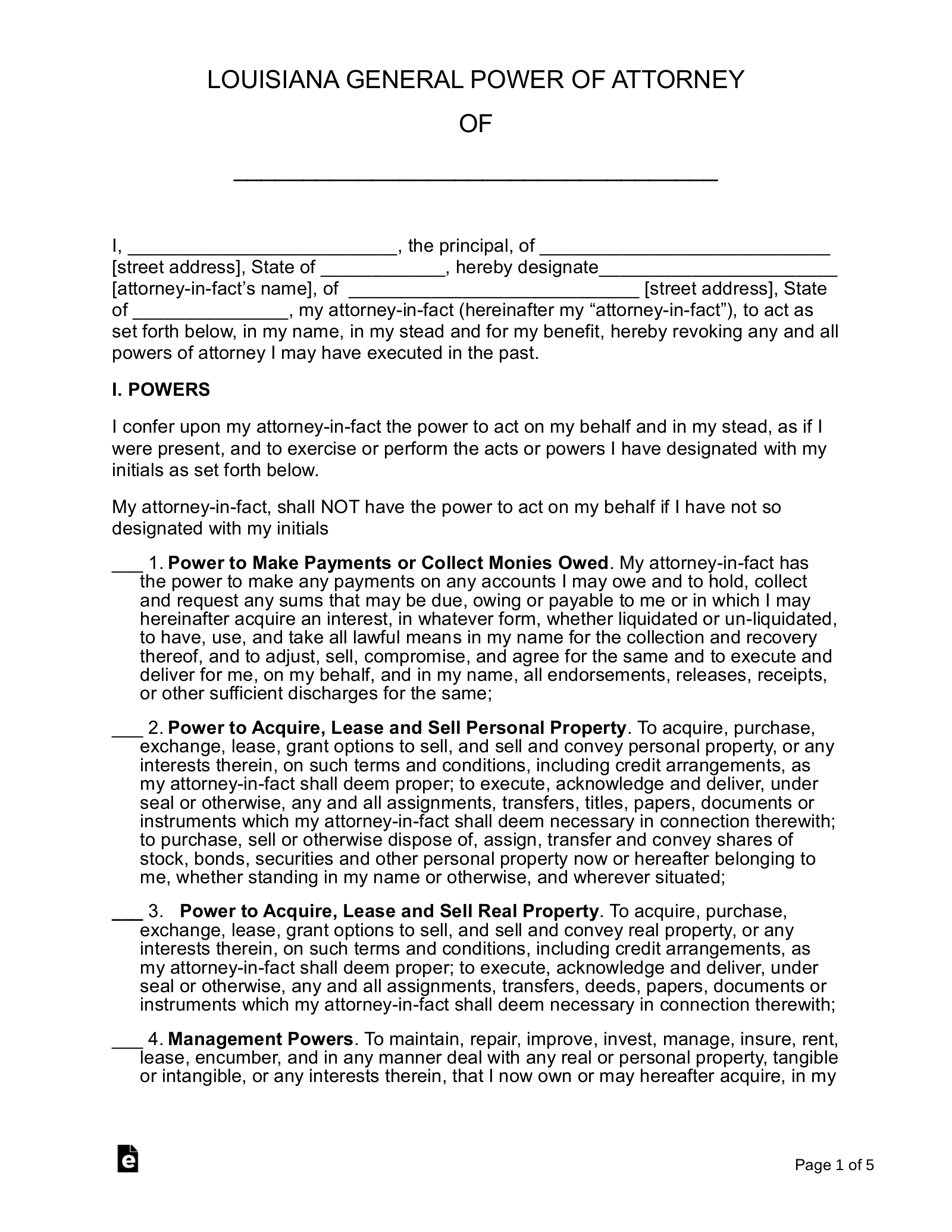Updated August 08, 2023
A Louisiana general (financial) power of attorney allows an individual (the principal) to choose powers they want to grant to an attorney-in-fact (the agent) to use and act in their place. They can choose limited powers or all powers. This form is different from durable power of attorney because it does not continue and becomes void if the principal is unable to manage their own affairs. This seems counter-intuitive, but in fact, it takes into account the fact that if they are incapacitated they can’t revoke the power of attorney, so it can revoke itself. If they do want a power of attorney to continue despite incapacitation, they should use the durable form instead.
Laws
- Statutes – Mandate (§§ 2989 — 3034)
- Authority (La. Civ. Code art. 2994) – An agent under a power of attorney may act on behalf of the principal and exercise broad authority as granted by the agreement.
- Signing Requirements (La. Civ. Code art. 2993) – Only the principal must sign the document in order to execute it properly. However, the form should be notarized and/or witnessed to establish its validity.
How to Write
Download: PDF, MS Word, OpenDocument
1 – Record The Identity Of The Principal In The Title And Introductory Paragraph
The individual who is issuing this document and granting his or her Authority to another entity will need to be identified at the beginning of this form. First, enter this entity’s Legal Name on the blank line in the Title after the word “Of.” The individual granting Authority is known as the Principal and his or her identity must be included in the title.
Next, on the first empty line, between the word “I” and the words “the Principal…,” document the
Name of the Principal, making sure it is recorded precisely as it appears in the title. The report on the Principal should continue by reporting his or her Street Address and the State where he or she resides on the next two empty lines (in that order).
The report on the Principal should continue by reporting his or her Street Address and the State where he or she resides on the next two empty lines (in that order).
2 – The Attorney-in-Fact Accepting The Delegation Of Authority Must Be Presented
The rest of this paragraph will deal with who the Principal is granting his or her Principal Authority to. That is, the Attorney-in-Fact.
The first step in declaring who the Attorney-in-Fact is will be to enter his or her Legal Name on the empty space preceding the bracketed words “attorney-in-fact’s name.” Next, record the Building Number, Street, Unit Number, and County or City of the Attorney-in-Fact’s Residential Address on the next blank space following the bracketed words “Street Address.” The State where this Address is located should be entered on the final empty space of this paragraph.
Next, record the Building Number, Street, Unit Number, and County or City of the Attorney-in-Fact’s Residential Address on the next blank space following the bracketed words “Street Address.” The State where this Address is located should be entered on the final empty space of this paragraph.
3 – The First Article Requires Principal Approval
The introductory paragraph will lead into the section where the Principal’s Power in various topics will be discussed. Each paragraph in this numbered list will need to be initialed by the Principal in order for the Powers defined within it to be granted to the Agent or Attorney-in-Fact.
The first numbered item, labeled “Power to Make Payments or Collect Monies Owed,” refers to the Principal Power to use Principal Capital and Authority regarding debts. If the Principal wishes the Attorney-in-Fact to possess the ability to conduct business in the manner defined in this statement, the Principal will need to initial the blank space preceding the Number 1.  The next numbered item, “Power to Acquire, Lease and Sell Personal Property,” discusses the actions, decisions, and procedures the Attorney-in-Fact will have the Principal Authority to engage in, relating to Principal Personal Property. The Attorney-in-Fact will only be able to wield such Power if the Principal initials the blank space just before the Number 2.
The next numbered item, “Power to Acquire, Lease and Sell Personal Property,” discusses the actions, decisions, and procedures the Attorney-in-Fact will have the Principal Authority to engage in, relating to Principal Personal Property. The Attorney-in-Fact will only be able to wield such Power if the Principal initials the blank space just before the Number 2. The third numbered item, “Power to Acquire, Lease and Sell Real Property,” delivers a robust description of the Principal Authority the Attorney-in-Fact will wield in terms of the Principal’s Real Property. Such Authority will only be granted to the Attorney-in-Fact when the Principal initials the empty space corresponding with the Number 3.
The third numbered item, “Power to Acquire, Lease and Sell Real Property,” delivers a robust description of the Principal Authority the Attorney-in-Fact will wield in terms of the Principal’s Real Property. Such Authority will only be granted to the Attorney-in-Fact when the Principal initials the empty space corresponding with the Number 3. The next numbered item, “Management Powers,” provides the structured language required to grant the Attorney-in-Fact the Principal Power to manage any Real or Personal Property the Principal is responsible for on behalf of the Principal. This item must be initialed by the Principal if the described Principal Powers need to be granted to the Attorney-in-Fact.
The next numbered item, “Management Powers,” provides the structured language required to grant the Attorney-in-Fact the Principal Power to manage any Real or Personal Property the Principal is responsible for on behalf of the Principal. This item must be initialed by the Principal if the described Principal Powers need to be granted to the Attorney-in-Fact. The fifth numbered item, “Banking Powers,” will discuss the Principal Powers the Attorney-in-Fact may wield in the Principal’s Banks and other Financial Institutions using the Principal’s Name and on behalf of the Principal. These Powers may only be granted to the Attorney-in-Fact with the Principal’s initials on the blank line preceding the Number 5.
The fifth numbered item, “Banking Powers,” will discuss the Principal Powers the Attorney-in-Fact may wield in the Principal’s Banks and other Financial Institutions using the Principal’s Name and on behalf of the Principal. These Powers may only be granted to the Attorney-in-Fact with the Principal’s initials on the blank line preceding the Number 5.
If the Principal initials Item Six, he or she will deliver the Power of his or her Principal Authority regarding Motor Vehicles.
 The numbered item, “Tax Powers,” will give an extensive definition to how the Principal may grant his or her Power and Authority to the Attorney-in-Fact regarding Tax Paperwork, the I.R.S., and the Department of Revenue. Item Number 7 must be initialed by the Principal, if the Attorney-in-Fact should have these Powers.
The numbered item, “Tax Powers,” will give an extensive definition to how the Principal may grant his or her Power and Authority to the Attorney-in-Fact regarding Tax Paperwork, the I.R.S., and the Department of Revenue. Item Number 7 must be initialed by the Principal, if the Attorney-in-Fact should have these Powers.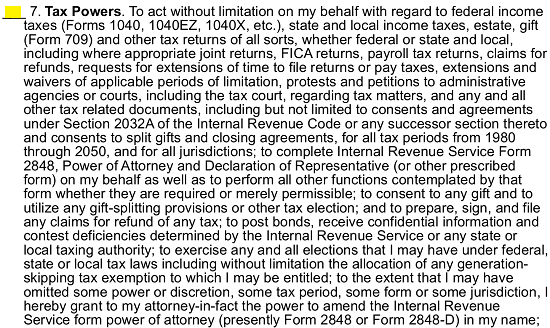 The “Safe Deposit Boxes” item (Number 8) contains the required language to deliver Principal Authority over the Principal’s Safe-Deposit Boxes to the Attorney-in-Fact, once it is initialed by the Principal.
The “Safe Deposit Boxes” item (Number 8) contains the required language to deliver Principal Authority over the Principal’s Safe-Deposit Boxes to the Attorney-in-Fact, once it is initialed by the Principal. The next numbered item, “Gift Making Powers,” discusses the manner in which the Principal Authority granted to the Agent may be used to make Gifts on behalf of the Principal. If the Attorney-in-Fact should be granted such Authority, he or she must initial this paragraph.
The next numbered item, “Gift Making Powers,” discusses the manner in which the Principal Authority granted to the Agent may be used to make Gifts on behalf of the Principal. If the Attorney-in-Fact should be granted such Authority, he or she must initial this paragraph. The numbered item labeled “Lending and Borrowing” will describe the Principal Powers to be granted to the Attorney-in-Fact that will enable the Attorney-in-Fact to lend and borrow in the Principal’s Name once the Principal initials the blank space preceding the Number 10.
The numbered item labeled “Lending and Borrowing” will describe the Principal Powers to be granted to the Attorney-in-Fact that will enable the Attorney-in-Fact to lend and borrow in the Principal’s Name once the Principal initials the blank space preceding the Number 10. The following numbered item, “Contracts,” gives the Attorney-in-Fact the Principal Power regarding the Principal’s existing Contracts and future Contracts. If the Attorney-in-Fact should have the Principal Authority to conduct the affairs listed in this item, then he or she should initial the blank space before the Number 11.
The following numbered item, “Contracts,” gives the Attorney-in-Fact the Principal Power regarding the Principal’s existing Contracts and future Contracts. If the Attorney-in-Fact should have the Principal Authority to conduct the affairs listed in this item, then he or she should initial the blank space before the Number 11.![]() The next item, “Health Care,” delivers the required language for the Principal to grant the Attorney-in-Fact with the ability to handle the Principal’s Health Care issues once the Principal initials the twelfth item.
The next item, “Health Care,” delivers the required language for the Principal to grant the Attorney-in-Fact with the ability to handle the Principal’s Health Care issues once the Principal initials the twelfth item. The “HIPPA” item, paragraph number 13, grants the Principal Powers as defined in the Health Insurance Portability And Accountability Act of 1996 to the Attorney-in-Fact, when the Principal initials the corresponding blank space.
The “HIPPA” item, paragraph number 13, grants the Principal Powers as defined in the Health Insurance Portability And Accountability Act of 1996 to the Attorney-in-Fact, when the Principal initials the corresponding blank space.![]() The item labeled “Power to Hire and Pay for Services,” details the Principal Power the Attorney-in-Fact may use to obtain, terminate, negotiate with, and compensate entities that provide services to the Principal in the name of the Principal, if the Principal initials the fourteenth list item.
The item labeled “Power to Hire and Pay for Services,” details the Principal Power the Attorney-in-Fact may use to obtain, terminate, negotiate with, and compensate entities that provide services to the Principal in the name of the Principal, if the Principal initials the fourteenth list item. The next numbered item, “Reimbursement of Attorney-in-Fact,” documents the required wording for the Attorney-in-Fact to use Principal Power in seeking and obtaining Reimbursement once it is initialed by the Principal.
The next numbered item, “Reimbursement of Attorney-in-Fact,” documents the required wording for the Attorney-in-Fact to use Principal Power in seeking and obtaining Reimbursement once it is initialed by the Principal.![]() If the Attorney-in-Fact should have the ability to sue entities who the Principal expects to observe the declarations of this document but do not, the Principal will need to initial the item Numbered 16.
If the Attorney-in-Fact should have the ability to sue entities who the Principal expects to observe the declarations of this document but do not, the Principal will need to initial the item Numbered 16.
The last numbered item in this list is labeled “Other.” Here, in item Number 17, the Principal will be able to provide specific instructions to the Attorney-in-Fact.
4 – The Exact Time Period When The Attorney-in-Fact’s Principal Power Must Be Declared
The next article, titled “Effective Date and Termination,” will provide a defined area where the Principal may solidify when he or she wishes the Powers granted in this document to the Attorney-in-Fact to go in Effect. That is when and how long will this Attorney-in-Fact’s granted Principal Power be valid. Article III is divided into two parts. The first will state when these Powers go into Effect, once the Principal initials the appropriate choice. Regardless of which choices the Principal applies, he or she will always retain the Power to Revoke these Powers in writing.
If the Principal wishes the Attorney-in-Fact to be able to wield Principal Authority as soon as he or she signs this document, then he or she will need to initial the first choice.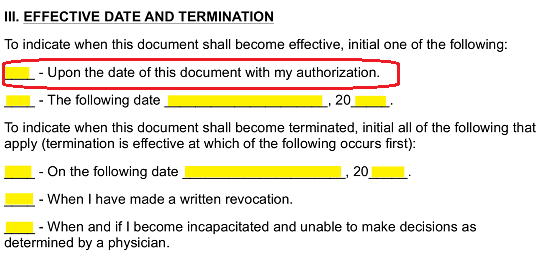
If the Principal desires the Authority listed here to be delivered only upon a specific Date then he or she should initial the second choice.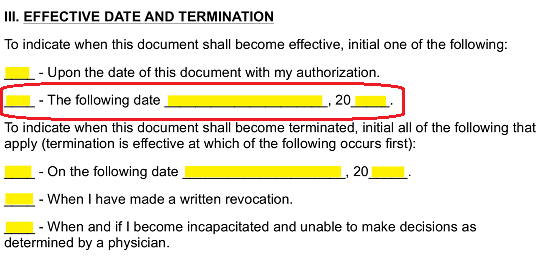 Once, the Principal has identified the determined starting Date, he or she will need to provide a definitive Date or Event of Termination.If the Principal wishes to automatically Terminate the Powers granted to the Attorney-in-Fact as of a specific Date, then he or she must initial the first choice and enter the Date of Termination he or she desires utilizing the blank lines after the word “…date”
Once, the Principal has identified the determined starting Date, he or she will need to provide a definitive Date or Event of Termination.If the Principal wishes to automatically Terminate the Powers granted to the Attorney-in-Fact as of a specific Date, then he or she must initial the first choice and enter the Date of Termination he or she desires utilizing the blank lines after the word “…date”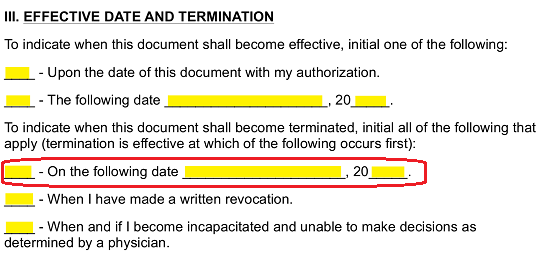 If the Principal Powers granted here may only be terminated by a written revocation issued by the Principal, he or she must initial the second choice.
If the Principal Powers granted here may only be terminated by a written revocation issued by the Principal, he or she must initial the second choice.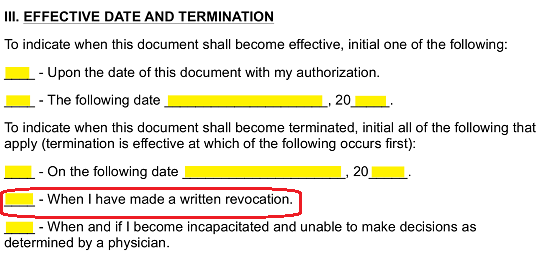 If the Principal Authority being delivered to the Attorney-in-Fact will only be terminated by the Principal being declared Incapacitated or Disabled by a Physician, then he or she should initial the third Choice.
If the Principal Authority being delivered to the Attorney-in-Fact will only be terminated by the Principal being declared Incapacitated or Disabled by a Physician, then he or she should initial the third Choice.
5 – The Finalization Of This Form Will Be Delivered By The Principal and Supporting Entities
The final article, “Third Party Reliance,” will be followed by a statement with three blank spaces. This statement will name the Date of Signature for this document. The Principal must enter the two-digit Calendar Day, the written Month, and the two-digit Year when he or she is signing this document. Below this, the Principal must Sign his or her Name then present the Printed version below the Signature.
Below this, the Principal must Sign his or her Name then present the Printed version below the Signature. The “Acceptance of Appointment” statement will require the Printed Name of the Attorney-in-Fact on the first empty line. Once the Attorney-in-Fact has reviewed and agreed to this statement, he or she must sign and print his or her Name on the blank lines labeled “Attorney-in-Fact’s Signature” and “Attorney-in-Fact’s Printed Name.”
The “Acceptance of Appointment” statement will require the Printed Name of the Attorney-in-Fact on the first empty line. Once the Attorney-in-Fact has reviewed and agreed to this statement, he or she must sign and print his or her Name on the blank lines labeled “Attorney-in-Fact’s Signature” and “Attorney-in-Fact’s Printed Name.”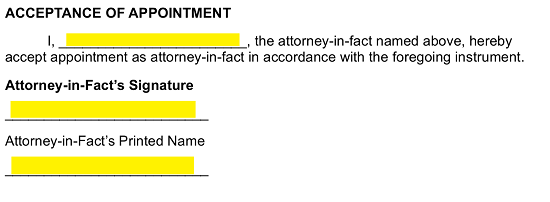 The “Witness” statement will need to be reviewed and agreed to by two unique Witnesses. Each one will have his or her own Signature Line and two corresponding lines to provide his or her Residential Address.
The “Witness” statement will need to be reviewed and agreed to by two unique Witnesses. Each one will have his or her own Signature Line and two corresponding lines to provide his or her Residential Address. Upon the successful signing of this form, the Notary Public will subject it to the Notarization Process using the “Acknowledgment of Notary Public” section.
Upon the successful signing of this form, the Notary Public will subject it to the Notarization Process using the “Acknowledgment of Notary Public” section.